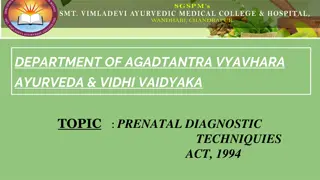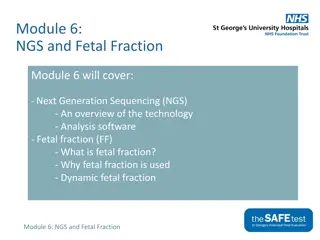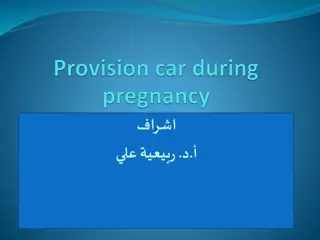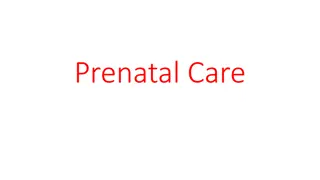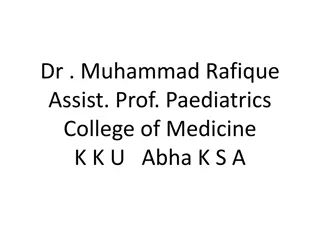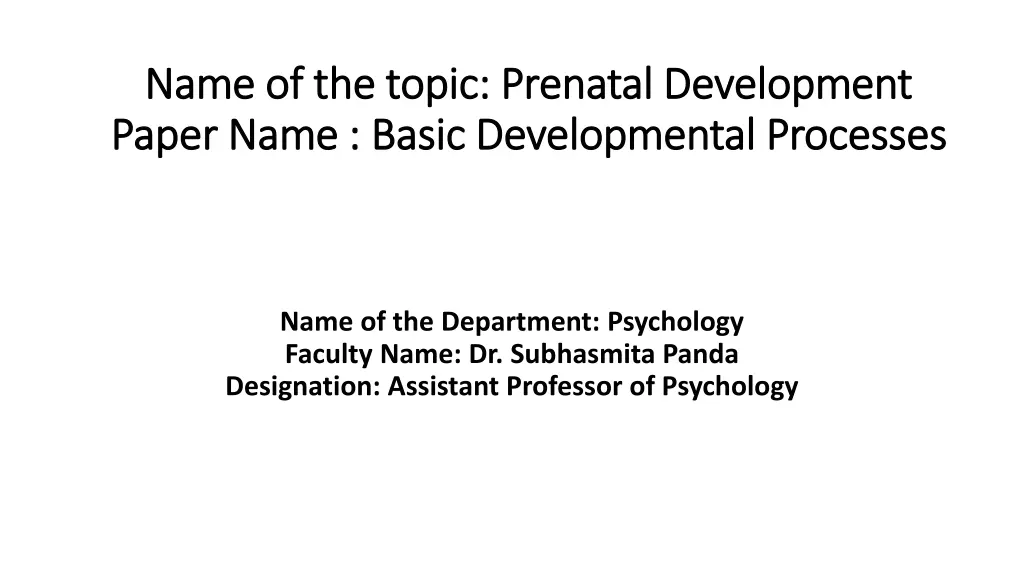
Understanding Prenatal Development: Stages and Significance
Explore the fascinating journey of prenatal development from conception to birth, detailing the germinal and embryonic periods, and the role of the placenta and umbilical cord in nourishing the growing fetus. Delve into the intricacies of organogenesis and the formation of vital structures essential for fetal growth and well-being.
Download Presentation

Please find below an Image/Link to download the presentation.
The content on the website is provided AS IS for your information and personal use only. It may not be sold, licensed, or shared on other websites without obtaining consent from the author. If you encounter any issues during the download, it is possible that the publisher has removed the file from their server.
You are allowed to download the files provided on this website for personal or commercial use, subject to the condition that they are used lawfully. All files are the property of their respective owners.
The content on the website is provided AS IS for your information and personal use only. It may not be sold, licensed, or shared on other websites without obtaining consent from the author.
E N D
Presentation Transcript
Name of the topic: Prenatal Development Name of the topic: Prenatal Development Paper Name : Basic Developmental Processes Paper Name : Basic Developmental Processes Name of the Department: Psychology Faculty Name: Dr. Subhasmita Panda Designation: Assistant Professor of Psychology
Prenatal development Prenatal stages: Conception, the beginning of life occurs when the genetic material of the sperm and egg unite to form a single celled Zygote. The zygote contains the 46 chromosomes that are the genetic blueprint for the individual s development. It takes about 266 days (about 9 months) for the zygote to become a fetus of billion cells that is ready to born. The prenatal development is divided into three stages:
1. The germinal period: Lasts approximately 2 weeks Day 1: fertilization usually occurs within 24 hours of ovulation 2: the single celled zygote begins to divide 24-36 hours after fertilization 3-4: the mass has 16 cells and is called as a morula; it is travelling down the fallopian tube to uterus 5: the inner cell mass forms; the entire mass is called as a balstocyst and is the size of a pin head 6-7: the blastocyst attaches to the wall of the uterus 8-14: the blastocyst becomes fully embedded in the wall of the uterus. It now has about 250 cells.
2. The embryonic period: Occurs from third to the eighth week after conception Every major organs takes shape, in at least a primitive form: the process is called as organogenesis. The layers of blastocyst differentiate, forming structures that sustain development The outer layer becomes both the amnion: a watertight membrane that fills with fluid that cushions and protects the embryo and Chorion: a membrane that surrounds the amnion and attaches root like extension called as villi to the uterine lining to gather nourishment for the embryo The chorion eventually becomes the lining of the placenta, a tissue fed by blood vessel from the mother and connected to the embryo by the umbilical cord. Through placenta and umbilical cord , the embryo receives oxygen and nutrients from the mother and eliminates carbon dioxide and metabolic waste into the mother s bloodstream.
The Placenta and Umbilical Cord The Placenta and Umbilical Cord
Placental barrier The cells in the interior of the blastocyst give rise to the ectoderm, mesoderm and endoderm. These will eventually evolve into specific tissues and organ systems including: Central nervous system (brain and spinal cord ) from the ectoderm Muscle tissue, cartilage, bone, heart, arteries, kidneys and gonads from the mesoderm Gastrointestinal tract, lungs, bladder from the endoderm Development proceed at a breathtaking pace Beginning of the brain are apparent after only 3 to 4 weeks, when the neural plate folds up to form neural tube The bottom of the tube becomes spinal cord Lumps emerge at the top of the tube and form forebrain, midbrain and hindbrain The primitive or lower portion of the brain develop earliest. They regulate biological functions as digestion, respiration, and elimination; also control sleep-wake states and permit simple motor reactions
In as many as 5 out of 1000 pregnancies, the neural tube fails to fully close. It can lead to spina bifida, in which part of spinal cord is not fully encased in the protective covering of the spinal column.(Spina bifida can cause paralysis below the spine) Failure to close can lead to anencephaly: in which the main portion of the brain above brain stem fails to develop Neural tube defects occur 25 to 29 days after conception and more common when the mother is deficient in folic acid, a substance critical for normal gene function. During the second month, a primitive nervous system also makes newly formed muscles contract The important process of sexual differentiation begin during seventh and eighth prenatal week Undifferentiated tissue becomes either male testes or female ovaries The testes of a male embryo secrete testosterone, the primary male sex hormone
3. The fetal period: Lasts from the ninth week of pregnancy until birth It encompasses part of the first trimester, all of middle and last trimester. It is a critical period of brain development, which involves three processes: 1. Proliferation of neurons: involves their multiplying at a staggering rate during this period The number of neurons increases by hundreds of thousands every minute throughout all of pregnancy, with a concentrated period of proliferation occurring between 6 and 17 weeks after conception As a result of this rapid proliferation, the young infant has around 100 billion neurons. 2. Migration: the neurons move from their place of origin in the center of the brain to particular locations throughout the brain where they will become part of specialized functioning units. Migration is influenced by genetic instructions and by the biochemical environment in which brain cells find themselves. Although this process occurs throughout the prenatal period, much of it occurs between 8 and 15 weeks after conception 3. Differentiation: early in development, every neuron starts with the potential to become any specific type of neuron; what it becomes-how it differentiates-depends on where it migrates. If a neuron that would normally migrate to the visual cortex of an animal s brain is transplanted into the area of cortex that controls hearing, it will differentiate as an auditory neuron instead of a visual neuron.
Organ systems that formed during the embryonic period continue to grow and begin to function. By the end of the first trimester of pregnancy, it moves its arms, kicks its legs, makes fists, and even turns somersaults in its own little amniotic fluid-filled gymnasium. The mother probably does not yet feel all this activity because the fetus is still only about 3 inches long. Other behaviors are also evident at this stage: swallowing, yawning, hiccupping, and urinating. These early actions contribute to the proper development of the nervous system, respiratory system, digestive system, and other systems of the body, and they are consistent with the behaviors that we observe after birth At about 23 weeks after conception, midway through the fifth month, the fetus reaches the age of viability, when survival outside the uterus is possible if the brain and respiratory system are sufficiently developed. The age of viability is earlier today than at any time in the past because medical techniques for keeping fragile babies alive have improved considerably over the past few decades. Although there are cases of miracle babies who survive severely premature birth, many infants born at 22 25 weeks do not survive, and of those who do, many experience chronic health or neurological problems
In terms of growth, it is primarily all about length during the second trimester and then weight during the third trimester. During the second half of pregnancy, neurons not only multiply at an astonishing rate (proliferation) but they also increase in size and develop an insulating cover, myelin, that improves their ability to transmit signals rapidly. Guided by both a genetic blueprint and early sensory experiences, neurons connect with one another and organize into working groups that control vision, memory, motor behaviour, and other functions As the brain develops, the behaviour of the fetus becomes more like the organized and adaptive behaviour seen in the newborn.
By the middle of the ninth month, the fetus is so large that its most comfortable position in cramped quarters is head down with limbs curled in (the fetal position ). The mother s uterus contracts at irregular intervals during the last month of pregnancy. When these contractions are strong, frequent, and regular, the mother is in the first stage of labor and the prenatal period is drawing to a close.


